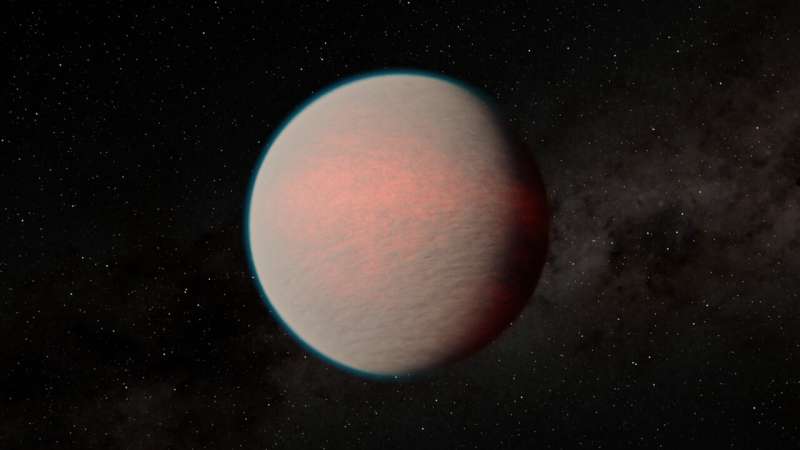
August 20, 2024 by ETH Zurich
Collected at: https://phys.org/news/2024-08-exoplanets-previously-thought.html
We know that the Earth has an iron core surrounded by a mantle of silicate bedrock and water (oceans) on its surface. Science has used this simple planet model until today for investigating exoplanets—planets that orbit another star outside our solar system.
“It is only in recent years that we have begun to realize that planets are more complex than we had thought,” says Caroline Dorn, Professor for Exoplanets at ETH Zurich.
Most of the exoplanets known today are located close to their star. This means they primarily comprise hot worlds of oceans of molten magma that have not yet cooled to form a solid mantle of silicate bedrock like the Earth. Water dissolves very well in these magma oceans—unlike, for instance, carbon dioxide—which quickly outgasses and rises into the atmosphere.
The iron core is located beneath the molten mantle of silicates. So how is the water distributed between the silicates and the iron?
This is precisely what Dorn has investigated in collaboration with Haiyang Luo and Jie Deng from Princeton University with the help of model calculations based on fundamental laws of physics. The researchers present their results in the journal Nature Astronomy.
Magma soup with water and iron
To explain the results, Dorn has to go into some detail: “The iron core takes time to develop. A large share of the iron is initially contained in the hot magma soup in the form of droplets.” The water sequestered in this soup combines with these iron droplets and sinks with them to the core. “The iron droplets behave like a lift that is conveyed downwards by the water,” explains Dorn.
Until now, this behavior had only been known to be the case for moderate pressures of the sort that also prevail on Earth. It was not known what happened in the case of larger planets with higher pressure interior conditions.
“This is one of the key results of our study,” says Dorn. “The larger the planet and the greater its mass, the more the water tends to go with the iron droplets and become integrated in the core. Under certain circumstances, iron can absorb up to 70 times more water than silicates. However, owing to the enormous pressure at the core, the water no longer takes the form of H2O molecules but is present in hydrogen and oxygen.”
Large amounts of water are also inside Earth
This study was triggered by investigations of Earth’s water content, which yielded a surprising result four years ago: The oceans on Earth’s surface only contain a small fraction of our planet’s overall water. The content of more than 80 of Earth’s oceans could be hidden in its interior. This is shown by simulations calculating how water behaves under conditions of the kind that prevailed when Earth was young. Experiments and seismological measurements are accordingly compatible.
The new findings concerning the distribution of water on planets have dramatic consequences for the interpretation of astronomical observation data. Using their telescopes in space and on Earth, astronomers can, under certain conditions, measure the weight and size of an exoplanet. They use these calculations to draw up mass-radius diagrams that permit conclusions to be drawn about the planet’s composition. If in doing so—as has been the case so far—the solubility and distribution of water are ignored, the volume of water can be dramatically underestimated by up to ten times.
“Planets are much more water-abundant than previously assumed,” says Dorn.
Understanding evolution history
Water distribution is also important if we wish to understand how planets form and develop. The water that has sunk to the core remains trapped there forever. However, the water dissolved in the magma ocean of the mantle can lose gas and rise to the surface during mantle cooling.
“So if we find water in a planet’s atmosphere, there is probably a great deal more in its interior,” explains Dorn.
This is what the James Webb Space Telescope, which for two years has been sending data from space to Earth, is seeking to find. It is capable of tracking down molecules in the atmosphere of exoplanets.
“Only the composition of the upper atmosphere of exoplanets can be measured directly,” explains the scientist. “Our group wishes to make the connection from the atmosphere to the inner depths of celestial bodies.”
The new data of the exoplanet called TOI-270d is particularly interesting.
“Evidence has been collected there of the actual existence of such interactions between the magma ocean in its interior and the atmosphere,” says Dorn, who was involved in the corresponding publication about TOI-270d. Her list of interesting objects that she wishes to examine more closely also includes the planet K2-18b, which hit the headlines because of the probability of there being life on it.
More information: The interior as the dominant water reservoir in super-Earths and sub-Neptunes, Nature Astronomy (2024). DOI: 10.1038/s41550-024-02347-z. www.nature.com/articles/s41550-024-02347-z
Journal information: Nature Astronomy

Leave a Reply